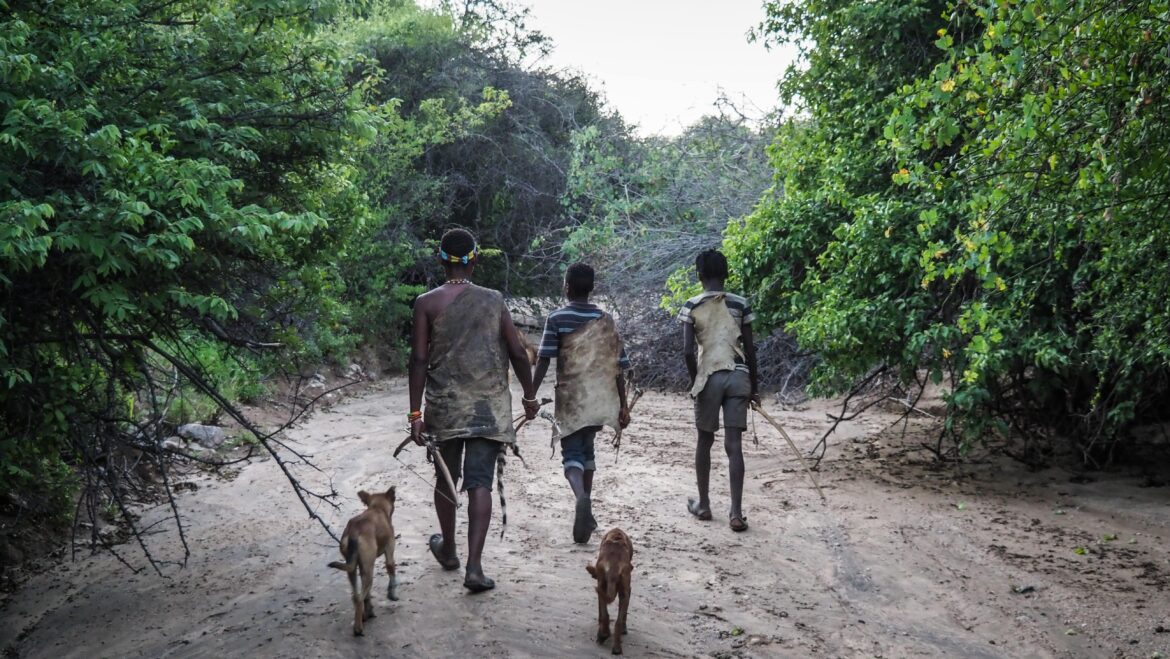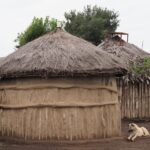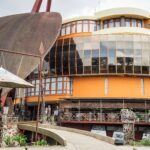Lake Eyasi is a shallow salt lake in northern Tanzania, located at the base of the Rift Valley. It lies southwest of the famous Serengeti National Park and just south of the Ngorongoro Crater. The lake’s size and water levels fluctuate dramatically depending on rainfall, sometimes nearly drying up in the dry season. The area provides a unique ecosystem that supports a variety of bird species, including flamingos and pelicans, making it an interesting destination for both cultural and ecological tourism.
Besides all that, what attracts tourists to the region around Lake Eyasi is the presence of the Hadzabe as well as the Datonga people.
Hadzabe Tribe
Indigenous ethnic group in Tanzania, primarily living around Lake Eyasi. They are one of the last remaining hunter-gatherer societies in the world, relying on hunting wild animals and foraging for fruits, roots, and honey. Their way of life has remained largely unchanged for thousands of years, and they do not practice agriculture or animal husbandry.
Men hunt wild animals such as antelope, baboons, and birds using handmade bows and poison-tipped arrows, while women forage for fruits, tubers, berries, and honey. Their deep knowledge of the land allows them to track animals with incredible precision and find food in harsh conditions.
Hadzabe society is egalitarian, meaning there are no formal leaders or social hierarchies. Decisions are made collectively, and resources are shared among the group. There is no concept of personal wealth as everything from food to tools is distributed based on need.
They live in small, mobile groups, often consisting of extended families. Their shelters are simple, temporary structures made of branches and leaves, reflecting their nomadic lifestyle. When resources become scarce in one area, they move to another.
The Hadzabe speak a unique click language, which is unrelated to the languages of their neighboring tribes. Their language is part of the Khoisan language family, similar to the click languages spoken by indigenous groups in southern Africa. This linguistic uniqueness sets them apart from the surrounding Bantu and Nilotic-speaking populations.
The Hadzabe do not follow a structured religion, but they have spiritual beliefs connected to nature and ancestral spirits. They believe in the power of the sun and moon and practice rituals to ensure good hunting and well-being. Storytelling, music, and dance are central to their culture, serving as both entertainment and a way to pass down traditions.
Historically, the Hadzabe have had minimal interaction with neighboring communities, such as the Datoga and Sukuma. However, they do trade with the Datoga, often exchanging honey and animal skins for metal arrowheads. Despite these interactions, the Hadzabe have largely resisted assimilation and continue to maintain their traditional way of life.
Despite the pressures of modernization, the Hadzabe remain resilient. Some efforts are being made to protect their land rights and support their traditional lifestyle. Conservation groups and anthropologists have worked to document their culture and help them navigate the challenges of the modern world without losing their identity.
Datonga Tribe
A semi-nomadic pastoralist group known for its skills in cattle herding, blacksmithing, and craftsmanship. Traditionally, its wealth and social status are measured by the number of cattle it owns.
They are believed to have migrated to Tanzania from the Ethiopian highlands centuries ago, making them one of the oldest ethnic groups in the region. They are closely related to other Nilotic pastoralists, such as the Maasai, but have maintained a distinct identity through their customs, language, and social structure.
Datoga society is organized into clans, with strong kinship ties and a patriarchal system where elders play a significant role in decision-making. Marriage is an important institution, often involving bride price payments in the form of cattle. Polygamy is common, especially among wealthy men who can afford multiple wives. Women have important roles in managing households, milking cattle, and crafting traditional clothing and ornaments.
One of the unique aspects of Datoga culture is their blacksmithing skills. While they are primarily herders, some subgroups specialize in metalwork, creating tools, knives, spears, and arrowheads, which they trade with neighbouring communities, including the Hadzabe. This trade has historically been essential for both groups – the Hadzabe provide honey and animal skins, while the Datoga supply metal tools.
The Datoga have a rich spiritual tradition that is deeply connected to nature and ancestor worship. They believe in a supreme deity, whom they associate with the sky, rain, and fertility. Rituals, sacrifices, and ceremonies are common, especially during important life events such as birth, initiation, marriage, and death.
Like many indigenous groups, the Datoga face increasing challenges due to modernization, land encroachment, and government policies promoting settled lifestyles. Some have adapted by incorporating small-scale farming, but others resist change, striving to preserve their nomadic traditions. Education levels remain low among the Datoga, as formal schooling is not traditionally emphasized in their society.
How to get there?
By Air
The nearest major airport is Kilimanjaro International Airport (JRO), located near Arusha. From there it’s 250 km (around 5-7 hours) to Lake Eyasi.
By Road
Most visitors travel to Lake Eyasi by road, usually as part of a safari tour but reaching it by public transport is also possible.
From Arusha: The drive takes about 4 to 5 hours via Karatu. The road is well-paved until Karatu, but the final stretch to Lake Eyasi is a rough dirt road.
If travelling by public transport, take a local bus or shared taxi (dala-dala) from Arusha to Karatu, and then change to a shared 4×4 Land Cruiser, or hire a private car or motorcycle to reach the lake.
From Ngorongoro Crater: If you’re coming from Ngorongoro, it’s about a 2 to 3-hour drive.
From Serengeti: It takes about 5 to 6 hours, depending on your starting point in the park.

The best time to visit
The best time to visit Lake Eyasi is during the dry season, from June to October, when the weather is cooler, and wildlife is easier to spot. During this period, the lake’s water levels are lower, attracting a variety of bird species, including flamingos. It’s also an excellent time to interact with the Hadzabe and Datoga communities, as access to their villages is easier due to dry roads.
The wet season (November to May) brings lush landscapes and fuller water levels, making it a great time for birdwatching. However, travel can be more challenging due to muddy roads, and some areas may be inaccessible. If you’re interested in cultural experiences, both seasons offer opportunities to meet local tribes, but the dry season is generally more convenient for travel.
Where to stay?
I stayed in Sarafina Guesthouse. The rooms were clean but there were lots of mosquitos inside. Luckily, a good-quality net above the bed was provided but I could still hear them buzzing which was disturbing.
You may also consider staying in Ziwani Lodge or Eyasi Safari Motel.

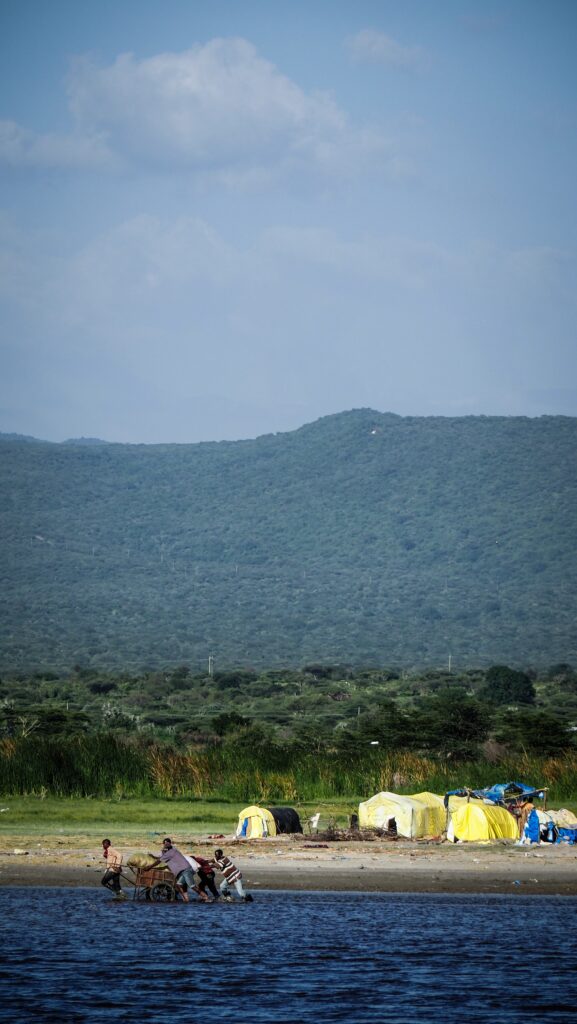
Going independently or with a guide?
Lake Eyasi can be reached independently although most people come there as a part of a safari trip including national parks. If you decide to do it by yourself, use public transport from Arusha to reach Karatu and then Mang’ola.
Upon arrival, ask your guesthouse or motel to arrange a guide and motorbike taxi to the shore of Lake Eyasi or Hadzabe and Datonga villages.
If you prefer taking a guide from Arusha, I recommend getting in touch with Daudi (+255 621 146 836). He is a great guy who speaks English very well and will help you to get around Arusha and its surroundings. The trip to Lake Eyasi (2 Days 1 Night), including public transport, accommodation and visits to tribes will cost you about 150 – 170 USD, depending on your negotiation skills. I don’t recommend a one-day trip as you will spend most of the time on the bus and you won’t get the chance to join hunting together with Hadzabe.
My experience
Day 1
I had an early morning breakfast and then went to the meet with Daudi, who was again my guide. A few days before we did a walking tour in Arusha and that was when we decided to go to Lake Eyasi together. We found a shared car (locally called Noah) heading to Karatu, where we changed for the shared jeep (old Land Rover Defender) heading towards Mang’ola Village. Both vehicles were full to the limits, and even changing sitting position was difficult. Tanzanians have the unique ability to squeeze themselves and even the driver shared his seat with another passenger!
The jeep dropped us in front of the guesthouse. The room was okay and there was even hot water, but it was full of mosquitos. Luckily, as usual in Tanzania, a mosquito net was provided.
Soon, the local guide arrived on his motorcycle and we went to the lakeside. There were a lot of fishermen, living in temporary tents made of some kind of plastic foil and wood. Apparently, they come from different parts of the country to spend a few months at the lake to do fishing and earn money.
A group of local boys took us on a short boat trip. They paddled around and we got closer to fishing nets and made a stop on a small sand bank. There, we waited for the sunset. Fishermen were pulling the nets out of the lake and it looked like a really hard work. They had ropes attached to their waist and were making characteristic movements forward and backwards.
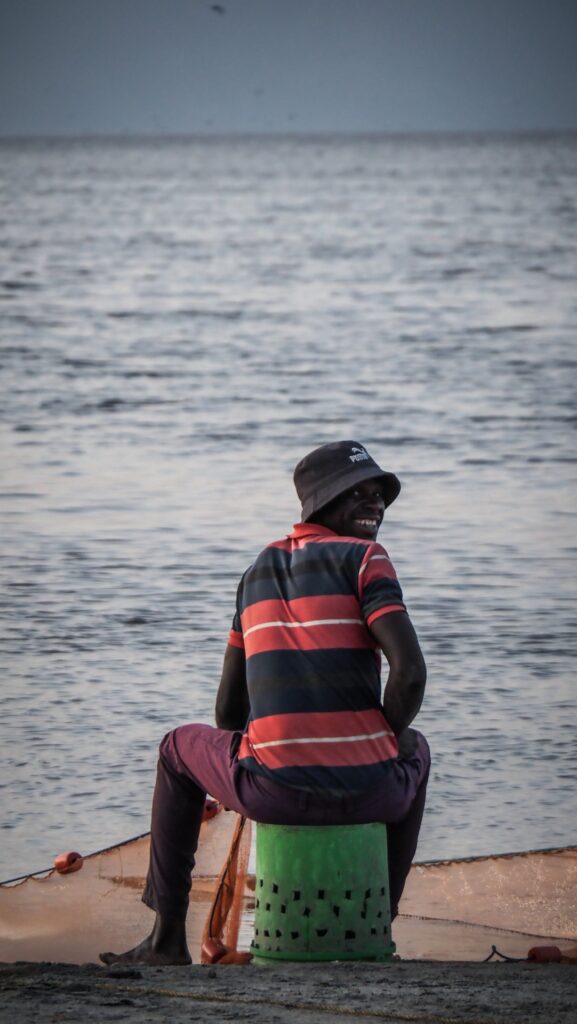
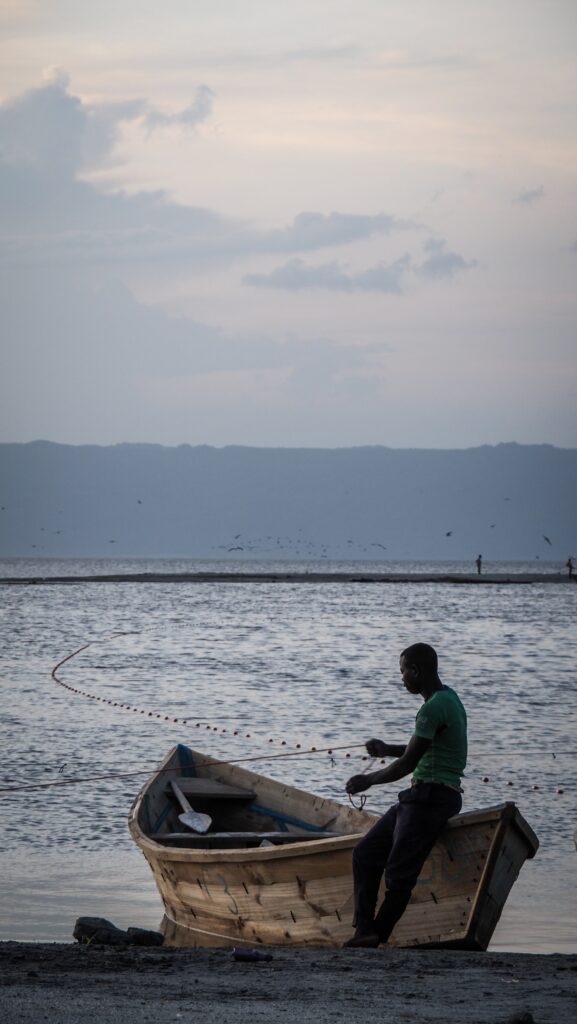

After sunset, we went to eat dinner in a local bar/restaurant. A very kitschy place with mediocre food but there were no alternatives. Then, we went back to the accommodation, agreed on the plan for the next day and Daudi explained to me a bit about what we could see in the sky. The conditions were great for stargazing as there was minimal light pollution in the village.
The night was quite bad as it was very hot to sleep and the mosquitos were buzzing outside of the net like crazy. I think sleeping in that room without a mosquito net would be suicidal!

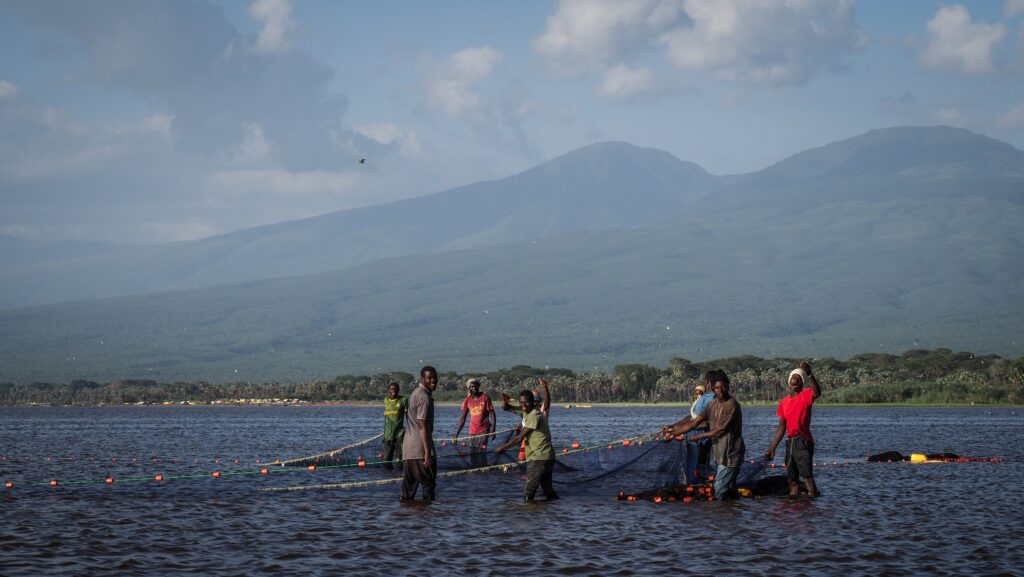

Day 2
We woke up at 4:30 AM and left the guesthouse at 5 AM when it was still pitch black but the night sky looked amazing as it was full of stars! The motorbike ride took nearly an hour, and when we arrived at the Hadzabe tribe, they were still sleeping. The fire smoldered in the fireplace and after a moment a figure emerged from the darkness to greet us.
A father with his two children got ready for the hunt and we joined them. We walked for quite a bit until we reached a dry river bed and started following it looking for prints of animals on the sand. For quite a long time Hadzabe were trying to chase warthog but unsuccessfully. Following them wasn’t easy as the vegetation was thick and full of thorns and I had a backpack.

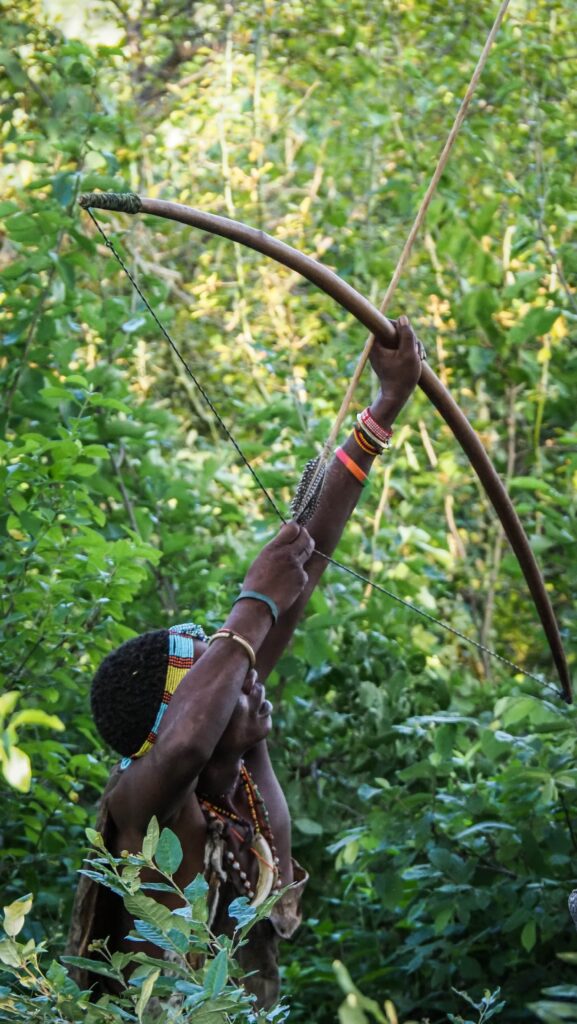
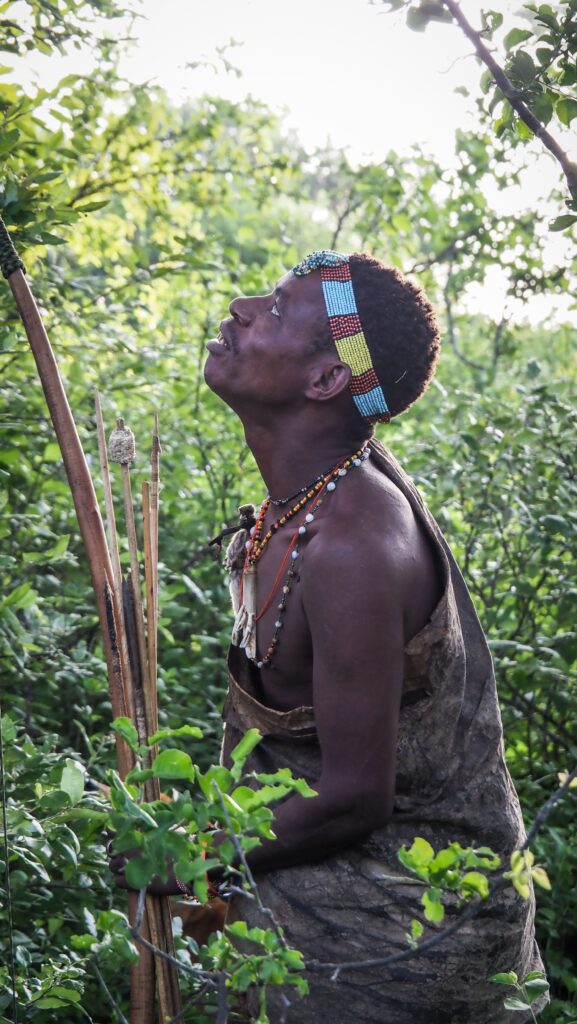
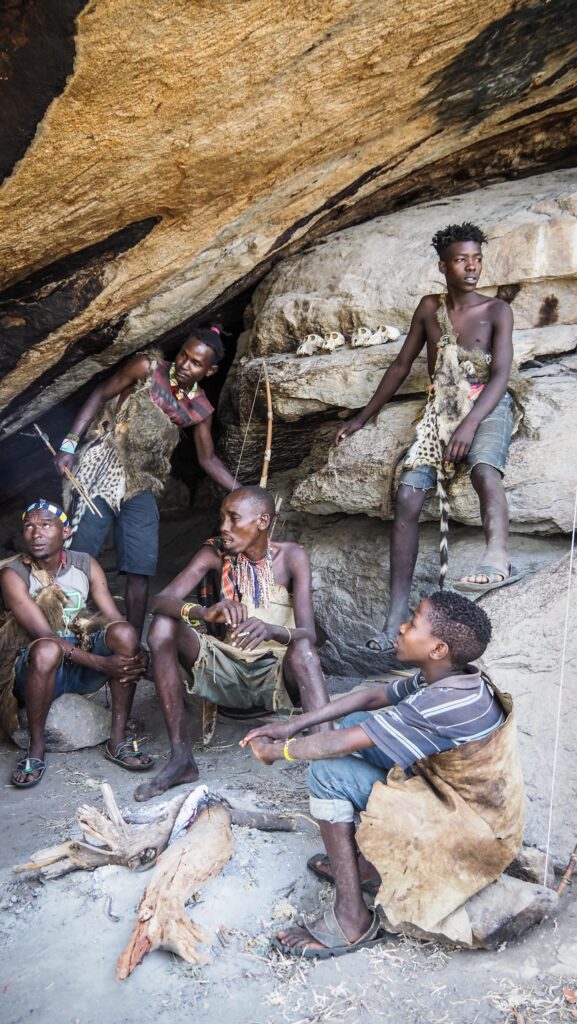
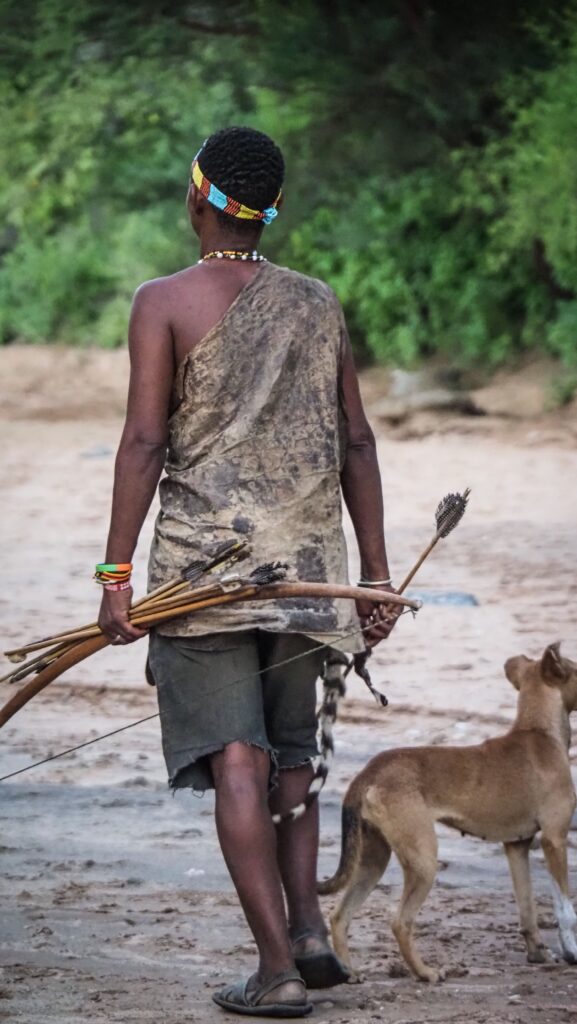

The warthog was lucky enough to get away so Hadzabe started trying to get the monkey. It was sitting on a huge baobab tree so they were throwing stones, hoping for the monkey to change position and get in the range of the arrows. After probably an hour of trying, climbing the tree and doing all the tricks, they had to give up. It wasn’t a lucky day for the Hadzabe and it showed that hunting for wild animals isn’t easy at all!
We made a small break and the father with his two sons (10-14 years old) shared… a giant joint. Then, we walked deeper into the bush again looking for the traces of animals but in the end, we came back to camp with empty hands. I tried shooting from the bow, took some more pictures of people and the visit was concluded with a short dancing performance. That part felt a bit too touristy for me.
We jumped on motorbikes again and went to the Datonga tribe. We watched them making an arrowhead from the start to finish: melting old iron, putting it into long and thin form, and then using a hammer and other tools to shape it. Quite boring to be honest! I wanted to take some pictures of people but they were very shy and not willing to look in the camera.



Then, we went for a quick lunch before we were dropped in the lodge to pick up the things and wait for the jeep heading back to Karatu. There, we changed to the shared car heading to Arusha and luckily the driver offered us paying for an extra seat so we could leave immediately without waiting for more passengers. We also had more space which was so much more comfortable!

